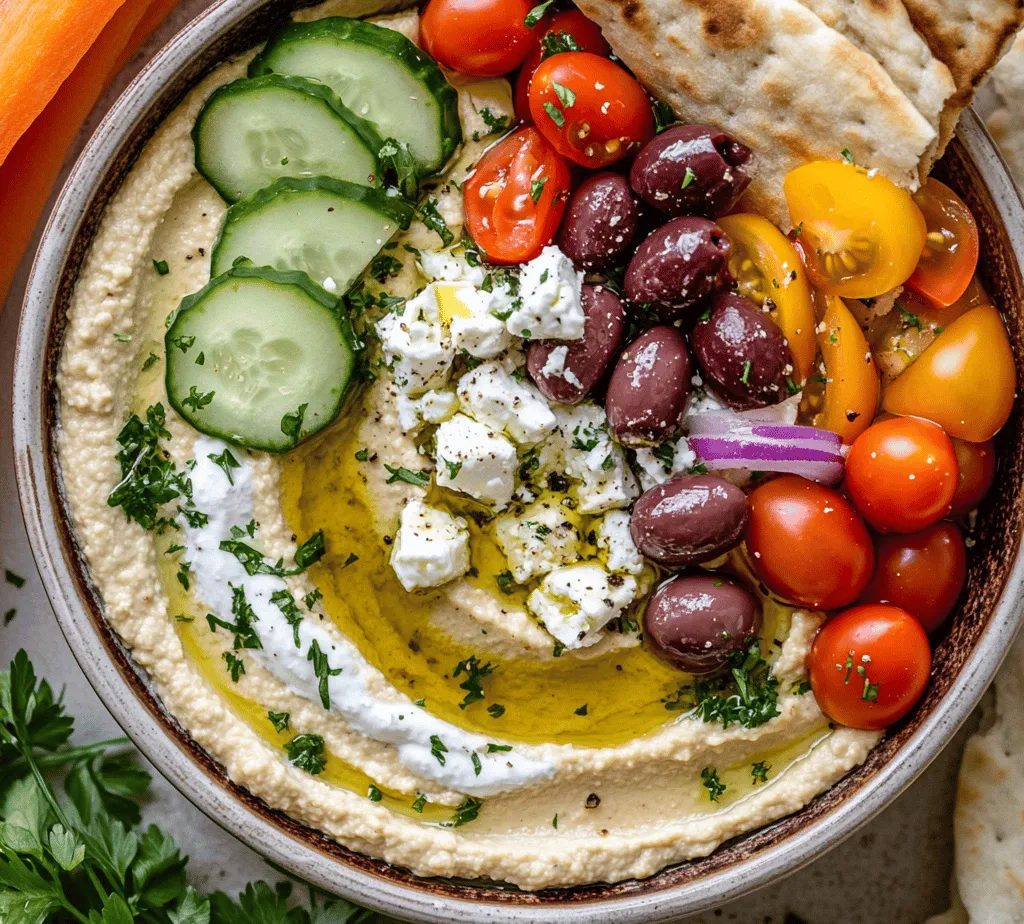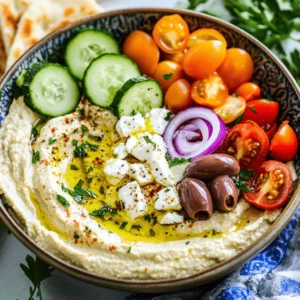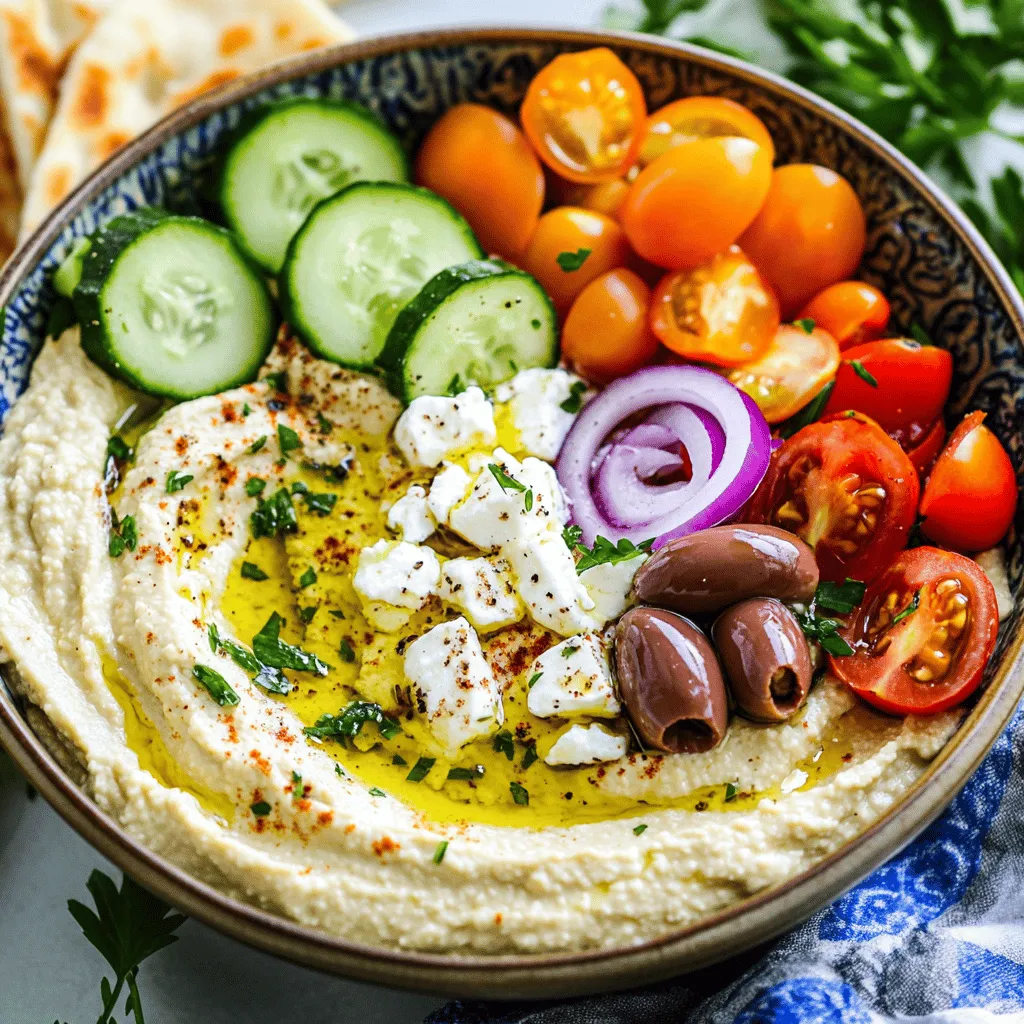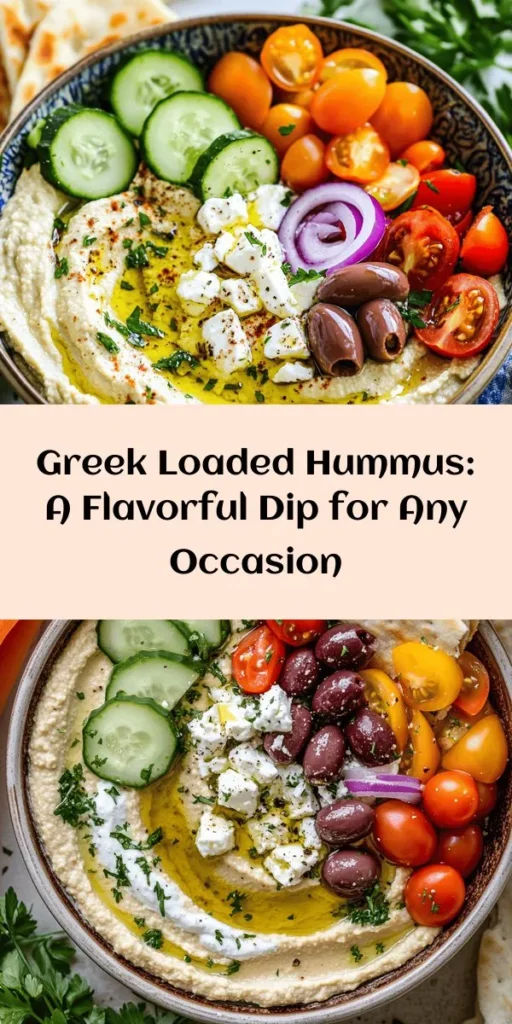Introduction
Hummus is not just a dish; it is a culinary staple that has transcended borders and cultures, becoming a beloved component of Mediterranean cuisine. With its creamy texture and rich flavor, hummus serves as a versatile appetizer that can be enjoyed with pita bread, fresh vegetables, or as a component of a larger meal. In modern diets, where health-conscious choices are at the forefront, hummus stands out as a nutrient-rich option that combines deliciousness with nutritional benefits.
Enter the Greek Style Loaded Hummus—a vibrant take on the traditional chickpea spread that elevates the standard recipe by incorporating fresh Mediterranean toppings. This loaded version not only enhances the flavor profile but also adds a delightful array of textures, making it an ideal choice for gatherings, parties, or simply as a wholesome snack. Whether you’re hosting a dinner party or looking for a nutritious snack to enjoy at home, this recipe promises to impress with its freshness and flavor.
The Allure of Hummus
The origins of hummus can be traced back to the Middle East, where it has been enjoyed for centuries. Historically, this dish has been a staple in various cultures, with each region adding its unique twist. While the exact origins remain somewhat disputed, it is widely accepted that hummus was first created in the Levant region, which encompasses parts of modern-day Lebanon, Syria, and Israel. Over the years, hummus has gained international acclaim, making its way into kitchens and restaurants around the globe.
From a nutritional perspective, hummus is packed with health benefits, primarily due to its key ingredient—chickpeas. Chickpeas, or garbanzo beans, are an excellent source of plant-based protein, fiber, and essential vitamins and minerals. They are known to support digestive health, stabilize blood sugar levels, and promote heart health due to their high fiber content and low glycemic index.
Another crucial component of traditional hummus is tahini, a paste made from ground sesame seeds. This ingredient not only contributes to the characteristic creamy texture but also adds healthy fats, vitamins, and minerals. With the rise of health-conscious eating and the popularity of plant-based diets, hummus has found its way into the hearts and diets of many, becoming a favorite among vegans, vegetarians, and omnivores alike. It’s no wonder that hummus has become a culinary trend, inspiring variations that cater to diverse palates.
Ingredients Breakdown
One of the standout features of Greek Style Loaded Hummus is the use of fresh ingredients that not only add flavor but also boost its nutritional profile. Let’s break down each ingredient to understand its role in this delicious dish.
Chickpeas
The foundation of hummus, chickpeas are a powerhouse of nutrition. A rich source of protein, dietary fiber, and essential minerals such as iron and magnesium, chickpeas are known to support satiety, helping you feel full longer. This makes hummus an excellent option for those looking to maintain a healthy weight. Additionally, the fiber found in chickpeas aids in digestion and promotes gut health, making it a smart choice for any diet.
Tahini
Tahini is more than just a flavor enhancer; it brings a unique creaminess to hummus that is hard to replicate. Made from ground sesame seeds, tahini contributes healthy fats, making hummus a satisfying and nourishing option. It is also rich in antioxidants and essential nutrients like calcium and magnesium. The nutty flavor of tahini complements the earthiness of chickpeas, creating a harmonious blend that is integral to the overall taste of hummus.
Olive Oil
When it comes to olive oil, quality matters. Extra virgin olive oil is the best choice for hummus, as it is cold-pressed and retains the most nutrients. Rich in monounsaturated fats, antioxidants, and anti-inflammatory properties, high-quality olive oil not only enhances the flavor of hummus but also contributes to its health benefits. Drizzling olive oil on top of the loaded hummus adds a finishing touch that elevates the dish.
Fresh Lemon Juice
The addition of fresh lemon juice is essential for balancing flavors in Greek Style Loaded Hummus. The acidity from lemons brightens the dish and cuts through the richness of tahini and olive oil. Furthermore, lemons are packed with vitamin C and antioxidants, making this ingredient both flavorful and healthful. The tanginess of lemon juice serves to enhance the overall taste, making every bite refreshing.
Garlic
Garlic is a must-have ingredient that brings depth to hummus. Known for its strong flavor and aroma, garlic not only enhances the taste but also provides numerous health benefits. Garlic is celebrated for its antibacterial and antiviral properties, making it a popular choice for boosting immunity. The pungent flavor of garlic complements the other ingredients beautifully, adding a savory note that rounds out the dish.
Ground Cumin
Ground cumin is a spice that adds a warm, earthy flavor to hummus. This aromatic spice is commonly used in Mediterranean cooking and brings a unique depth to the dish. Cumin is also known for its digestive benefits and is rich in antioxidants, making it a valuable addition to your hummus recipe. The subtle hint of cumin enhances the overall flavor profile, making it more complex and enjoyable.
Greek Yogurt
To take your Greek Style Loaded Hummus to the next level, Greek yogurt is added to introduce creaminess and a protein boost. Greek yogurt is thicker than regular yogurt, contributing to a luscious texture that makes the hummus even more indulgent. Beyond texture, Greek yogurt adds a slight tanginess that complements the other flavors beautifully, creating a well-rounded dish.
Fresh Vegetables
Fresh vegetables such as cucumbers, tomatoes, and red onions play a crucial role in adding texture and flavor to the loaded hummus. Cucumbers provide a refreshing crunch, while tomatoes add sweetness and juiciness. Red onions introduce sharpness that balances the richness of the hummus, making the overall experience more enjoyable. Additionally, these vegetables contribute essential vitamins and minerals, further enhancing the nutritional value of the dish.
Kalamata Olives and Feta Cheese
Both Kalamata olives and feta cheese are quintessential elements of Greek cuisine that elevate this hummus. Kalamata olives offer a briny, savory flavor that adds depth, while feta cheese introduces creaminess and a tangy note. These traditional ingredients not only enhance the taste but also pay homage to the dish’s Greek roots, making it a true Mediterranean delight.
Fresh Parsley
Finally, fresh parsley is used as a garnish to add color and a burst of freshness. This herb is not only visually appealing but also contributes a mild flavor that complements the other ingredients. Fresh parsley is also packed with vitamins A, C, and K, making it a nutritious addition to the dish.
Step-by-Step Instructions for Preparation
Now that we’ve covered the ingredients, let’s dive into the preparation process to create your Greek Style Loaded Hummus. The steps are straightforward, allowing you to whip up this delicious appetizer with ease.
1. Prepare the Chickpeas: If you’re using canned chickpeas, drain and rinse them under cold water to remove excess sodium. For a creamier texture, you can peel the skins off the chickpeas, although this step is optional.
2. Blend the Ingredients: In a food processor, combine the chickpeas, tahini, olive oil, fresh lemon juice, garlic, ground cumin, and Greek yogurt. Blend the mixture until it’s smooth and creamy. If the hummus is too thick, you can add a little water or more olive oil to reach your desired consistency.
3. Taste and Adjust: After blending, taste the hummus and adjust the seasoning. You may want to add more lemon juice, garlic, or salt, depending on your preference.
4. Transfer to a Serving Dish: Once you’re satisfied with the flavor and texture, transfer the hummus to a serving dish or bowl.
5. Add Toppings: Now comes the fun part—loading your hummus with toppings! Start by drizzling some extra virgin olive oil over the top. Then, add a generous amount of diced cucumbers, chopped tomatoes, and red onions. Crumble feta cheese over the vegetables and scatter Kalamata olives for that classic Greek touch. Finish with a sprinkle of fresh parsley for color.
With these steps, your Greek Style Loaded Hummus is ready to serve. This dish not only highlights the vibrant flavors of Mediterranean cuisine but also provides a nutritious option that will please any crowd. Stay tuned for the next part of our article, where we’ll delve deeper into serving suggestions, storage tips, and ways to customize this delicious recipe to suit your taste!

Tips for Achieving the Perfect Consistency
To create a Greek Style Loaded Hummus that is creamy and smooth, achieving the right consistency is crucial. Here are some essential tips to keep in mind:
1. Use Quality Ingredients: Start with high-quality tahini and fresh, ripe ingredients. The better the ingredients, the smoother the result.
2. Blend Thoroughly: Whether you’re using a food processor or a high-speed blender, blend the hummus for several minutes. Scrape down the sides occasionally to ensure that all ingredients are well incorporated.
3. Add Water Gradually: When blending, add water slowly, one tablespoon at a time, until you reach your desired creaminess. This method allows you to control the texture better.
4. Incorporate Ice Cold Water: For an extra creamy consistency, you can use ice-cold water. This helps emulsify the ingredients and creates a luscious, silky hummus.
5. Adjust with Olive Oil: A drizzle of extra virgin olive oil not only adds richness but also helps in achieving a smoother texture. Blend it in until fully incorporated.
6. Chill Before Serving: Allow your hummus to chill in the refrigerator for at least an hour before serving. This resting period can enhance the flavors and improve the texture.
Importance of Tasting and Adjusting Flavors
When crafting your Greek Style Loaded Hummus, tasting and adjusting flavors is essential for creating a dish that truly satisfies your palate. Here’s how to do it effectively:
– Season Gradually: Start with the basic spices and herbs, like garlic, lemon juice, and salt. Blend and taste, then add more as needed. This prevents overpowering the dish with too much seasoning upfront.
– Balance of Flavors: Greek Style Loaded Hummus should have a harmonious balance of creamy, tangy, and savory notes. If it tastes too tangy, consider adding a bit more tahini or a pinch of sugar to round out the flavors.
– Fresh Herbs: Fresh herbs like parsley or dill can elevate the flavor profile. Add these in small amounts and taste as you go along.
– Final Touches: Once you’ve blended your hummus and adjusted the seasonings, taste it one last time before serving. This is your opportunity to make any final tweaks for ultimate flavor satisfaction.
Arranging Toppings for Visual Appeal and Flavor Balance
Presentation plays a vital role in any dish, and your Greek Style Loaded Hummus is no exception. Here’s how to arrange your toppings:
– Layering Technique: Start by spreading your hummus in a shallow bowl, creating a well in the center for your toppings. This not only enhances visual appeal but also ensures even distribution.
– Variety of Textures: Arrange toppings with a variety of textures. For instance, sprinkle on crunchy pine nuts or slivered almonds, and add creamy dollops of Greek yogurt or feta for contrast.
– Color Coordination: Use colorful ingredients to create an eye-catching dish. Bright red tomatoes, vibrant green herbs, and golden olives create an inviting presentation.
– Drizzle with Olive Oil: A generous drizzle of high-quality olive oil over the top not only adds richness but also enhances the visual appeal of your hummus.
Serving Suggestions
Greek Style Loaded Hummus is versatile and perfect for many occasions. Here are some creative ways to serve it:
– Pair with Warm Pita Bread and Fresh Vegetable Sticks: Serve your hummus with warm pita bread, sliced cucumbers, carrot sticks, and bell pepper strips. This combination provides a delightful crunch and freshness.
– Appetizer for Gatherings: This dish is perfect as a crowd-pleasing appetizer for gatherings. Present it as part of a mezze platter alongside olives, cheeses, and stuffed grape leaves.
– Healthy Snack: Enjoy Greek Style Loaded Hummus as a nutritious snack. It’s a great option for midday cravings or post-workout fuel, packed with protein and healthy fats.
– Party Platter: Elevate your next party with a stunning hummus platter. Include a variety of toppings, dips, and sides for guests to mix and match with the hummus.
– As a Side Dish or Part of a Mezze Platter: Greek Style Loaded Hummus can also shine as a side dish. Pair it with grilled meats or fish to create a balanced meal that is both flavorful and nutritious.
Culinary Variations
Exploring variations of Greek Style Loaded Hummus can keep your meals exciting. Here are some ideas:
– Different Toppings: Experiment with various toppings to bring new flavors to your hummus. Consider roasted red peppers, marinated artichokes, or grilled vegetables for a twist.
– Vegan Alternatives: If you’re looking to keep it plant-based, you can replace Greek yogurt with a vegan alternative, such as cashew cream or coconut yogurt. For feta, consider using crumbled tofu mixed with nutritional yeast for a cheesy flavor.
– Flavor Variations: Spice up your hummus by incorporating spices or additional herbs. A pinch of smoked paprika can add depth, while fresh basil or cilantro can bring a bright note.
– Customized Dips: Feel free to blend in ingredients like sun-dried tomatoes, jalapeños, or roasted garlic for unique flavor profiles that cater to different tastes.
Nutritional Information
Understanding the nutritional content of Greek Style Loaded Hummus can help you appreciate its health benefits. Here’s a breakdown per serving (approximately ¼ cup):
– Calories: 150
– Carbohydrates: 10g
– Protein: 5g
– Fats: 10g
– Vitamins and Minerals: Rich in vitamins A, C, E, and K, along with iron, magnesium, and fiber.
Health Benefits of Consuming Hummus Regularly: Hummus is not just delicious; it’s also packed with health benefits. Made primarily from chickpeas, it’s a great source of plant-based protein and fiber, which aids in digestion and promotes heart health. The healthy fats from tahini and olive oil support brain function and can help reduce inflammation.
Cultural Significance of the Dish
Hummus holds a significant place in Greek and broader Mediterranean culture. Traditionally enjoyed as part of communal meals, it symbolizes hospitality and sharing.
– Essence of Mediterranean Eating: This dish embodies the essence of Mediterranean eating—fresh, flavorful, and health-conscious. It reflects the region’s focus on wholesome ingredients and balanced meals.
– Versatile Dish: Hummus can be adapted to various dietary preferences and occasions, from casual snacks to elegant appetizers, making it a staple in many households.
Conclusion
Greek Style Loaded Hummus is not only a vibrant and delicious addition to any meal, but it also offers a wealth of health benefits. Rich in protein, fiber, and healthy fats, it’s a nutritious choice that can easily be incorporated into your regular meal planning.
Encouraging you to try this dish, remember that cooking is about sharing and celebrating culture. By incorporating Greek Style Loaded Hummus into your meals, you can enjoy a flavorful and health-conscious option that delights the senses. So gather your ingredients, invite friends or family, and relish the joy of sharing food that brings people together.



